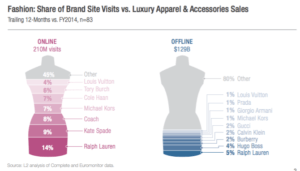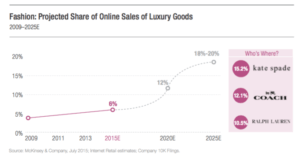IoT: The Internet of Trenchcoats

Burberry: Capitalizing on digital technology to revitalize an iconic brand.
Luxury and the Fourth Industrial Revolution
Burberry’s business model successfully pivoted from the traditional to the digital in an attempt to differentiate itself by connecting to millennials. Connectivity has been “dubbed the Fourth Industrial Revolution” and is “characterized by a fusion of technologies that is blurring the lines between the physical, digital and biological spheres”[1]. One could make the mistaken assumption that a brand historically associated with raincoats would be impervious to digitalization. Instead, this post suggests the luxury industry is experiencing rapid change and firms would benefit from following Burberry’s integration of the physical and digital realms. However, while Burberry has taken bold steps to position itself as a technologically savvy brand there is still room for improvement from an operational standpoint. Burberry should continue to invest in new technologies as it executes its customer promise: delivering the message, the feeling and the products customers expect of Britain’s leading luxury brand.
Why is Luxury at the Forefront of Change?
In 2014 online sales accounted for “6% of the €224 billion global market for luxury goods, but drove 80 % of growth” and this trend is only expected to increase [2]. However, traditional brand loyalty does not necessarily translate to online presence: “brand equity that took decades (if not centuries) to build does not transfer proportionately online”[2]. The diagram below shows how the “luxury market remains heavily fragmented in terms of offline sales, where as few as 7 brands generate over half of site visits”[2]. This suggests that brands that invest in improving their digital presence will benefit disproportionally in terms of online engagement and potential sales. Burberry was a leader in anticipating this trend and adapting accordingly. As described by Angela Ahrendts (CEO 2006-2014): “Everything we are going to do is target this millennial consumer, and if we do that we are going to speak in their language, and their language is rapidly becoming digital” [3].
How is Burberry Using Digital Technology to Develop its Business Model?
Burberry has embraced technology as a tool to create a deeper emotional connection between the brand and consumers. For example, Burberry’s monthly acoustic initiative streams live concerts from their flagship store to another 150 stores and mobile devices. Burberry picks local artists to reinforce the “Britishness” of the brand and create more authentic connections with consumers through music in today’s Youtube world. However, what really sets Burberry apart is its ability to blur the lines between the digital and physical in what some have described as a “phygital” business strategy [4]. For instance, Burberry recently added “magic mirrors in their fitting rooms… the mirror reads the tag of the items and shows a film of how the garment was made and what it looked like on the catwalk” (see video below)[4]. Burberry is ultimately able to express the firm’s heritage with a modern twist, through magic mirrors and streamed concerts, among other mediums.
Additional Operational Initiatives To Consider
Burberry has already made improvements aimed at aligning operations with its business strategy. According to the company, “consistent with our broader focus on merging the physical and digital, we made further investments to ensure our customers have a seamless experience of the brand…This included the expansion of our single pool of inventory”[5]. The latter provided better visibility of stock, improved product availability and meaningfully reduced delivery times. Additional investments could include:
- Radio-frequency Identification (RFID): codes garments in logistic centers and provides up-to-date information at any point during the distribution process; helps identify which garments need to be replaced in real-time to more accurately reflect demand and avoid bullwhip effects upstream.
- Expand functionality of fitting room mirrors: ability to request another size without having to leave fitting room. Display information on what past customers purchasing this garment have bought, similar to Amazon’s recommendations.
Why does this matter?
This post sought to explore a brand focused around an iconic product that might not have been greatly affected by technology. Instead, by embracing change Burberry has been able to differentiate itself and capture more value from the customer. When Ahrendts became CEO in 2006, “Burberry was growing at only 2% a year” but by “the end of fiscal 2012, Burberry’s revenues and operating income had doubled over the previous five years” [6]. For traditional brick-and-mortar companies, the digital wave has created new growth channels – in 2016 digital commerce remained Burberry’s “fastest growing channel, up 22% at constant exchange rates” [7]. However, it is important to keep the following in mind: “E-commerce is only one aspect of the digital opportunity…an additional 40% of luxury purchases are in some way influenced by consumers’ digital experience” [8]. Luxury firms that invest in “phygital” integration may discover new ways to revitalize their brand identity and fuel growth.
https://www.youtube.com/watch?v=6D5IZtDCS5c
Word Count: 786
References
[1] Euromonitor Passport. “2016 Digital Consumer Index: Identifying The Next Digital Frontiers”, Oct. 2016, p. 7.
[2] L2 Digital IQ Index. “Fashion”, Nov. 30th 2015, p. 2.
[3] https://www.youtube.com/watch?v=krQG2Hceov4&t=264s
[4] Dauriz, Linda, Nathalie Remy, and Nicola Sandri. “Luxury Shopping in the Digital Age.” McKinsey & Company, 01 May 2014. Web. 17 Nov. 2016.
[5] Burberry 2015 Annual Report, page 13
[6] Ahrendts, Angela. “Burberry’s CEO on Turning an Aging British Icon into a Global Luxury Brand.” Harvard Business Review, 31 July 2014. Web. 17 Nov. 2016.
[7] Burberry 2015 Annual Report, page 27
[8] Dauriz, Linda, Nathalie Remy, and Nicola Sandri. “Luxury Shopping in the Digital Age.” McKinsey & Company, 01 May 2014. Web. 17 Nov. 2016.







Maria, really interesting post!
I thought this was a great example of a company using digital technology very effectively in an unexpected way. One might think that high-tech customer interfaces would be antithetical to the Burberry brand image of a traditional 19th century clothing company; however, the video you shared drove home that retailers can creatively employ cutting-edge technology while still maintaining the look and feel of their brand identity.
This post made me realize that the “brick and mortar” retail experience—a model that has been relatively static over the past few decades—is likely to evolve meaningfully as companies find ways to use technology to improve the customer experience. I really liked your ideas on improving the fitting room experience with additional sizes on demand and “customers also bought” information. As I read this, another idea I contemplated was using digital technology to improve the fitting process. 3D scanners could figure out a person’s dimensions and then recommend a specific size / style for a clothing item. Farther in the future, perhaps retailers could use this 3D rendering to direct machines to instantaneously alter garments for the perfect fit. It seems like a number of startups are already working on technology of this sort (one interesting example: http://www.refinery29.com/2015/11/98373/body-labs-3d-modeling-fashion-technology-company).
Maria,
Very interesting post. I typically think of e-commerce as the main digital component of retail; however, this post clearly outlines that digital transformation reaches far beyond online sales. The digitization of the purchase process provides a wealth of data that likely leads to potential improvements in forecasting and inventory management. What impact does the digitization of purchases have on the bottom line for Burberry? I assume the operational efficiency drives significant profit improvement? Additionally, this post shows that the e-commerce arm is growing at a double digit rate. How will this impact the future operating model of Burberry? Will they scale back on brick and mortar stores with large inventory and shift towards digitally equip show rooms? Will they scale back on physical assets and decrease labor force as the online segment goes? How will the retail the luxury quality of the brand as things move increasingly digital?
Great article, Maria! I understand the impact that that digital sales and marketing trends have on luxury retailers, but this is the first time that I’ve heard of a “phygital” business strategy. I was blown away by the concept of Burberry’s digital store – it looks like something out of Blade Runner! I wonder what customers will value most, in the years ahead, when they walk into brick-and-mortar luxury retails shops: will they welcome the continuation of the same stream of digital marketing and advertising that already pervades every other screen in their lives? Or would many prefer a respite from the noise – a chance to engage with their considered purchases in peace, with a bit of personalized attention from a traditional sales attendant?
Interesting post! I agree with Dean that I expected to read about e-commerce when I clicked on this post since it is the main digital component of retail. I like the idea of adding functionalities to the fitting room mirrors, which could potentially drive additional sales by recommending matching outfits or shoes. However, these initiatives are largely dependent on physical stores as you mention the concept of “phygital”. I would be interested to know more about Burberry’s attempt to utilize digital or mobile platforms to increase consumers’ digital experience if there are any.
Maria,
Great post! Who would have thought a Trenchcoat company would be using digital technologies in their retail store. I was wondering what if Burberry could take this technology to their core trenchcoat product – perhaps integrate bluetooth in their coats and have an inbuilt headphone. This is obviously just a simple use case – one could obviously think of cooler applications. While, I don’t think there would be necessarily strong demand for such items – this would be in line with the modern brand image they are trying to communicate. Thoughts?
Maria – great article. Burberry certainly is leading when it comes to reinvigorating an iconic brand and expanding beyond the boundaries of what we defined as their scope (the trench) to a wider more digital range. One thought that comes to mind is the risk this transparency could create for copy cats. As the company builds such a robust digital experience, could this content be easily poached by others in the fashion space. What is the risk of fake companies reverse engineering clothing to create products that are indistinguishable. In addition, what about hackers who could use the digital store as a portal to “break into” the burberry back end and steal customer information? Clearly in addition to creating a strong digital presence Burberry will also need to safeguard this data and content to prevent issues that undermine the trust of its customers and consumers.
This post got me thinking about the rather unique challenges luxury brands are facing in the digitization era. Although it might be obvious for more mainstream brands like Zara and Asos to focus their efforts and capital on online platforms – not to mention market entrants who couldn’t afford to pursue brick & mortar strategies even if they wanted to – luxury brands may feel the need to make the shift more slowly in order to maintain the “elite” standing that enables them to sell at such high price points. At some point, even the luxury segment will need to get up to speed as millennials value time and convenience above all else. I’m liking Burberry’s hybrid approach to digitization, especially the emphasis on innovating within customer-facing stores. Although brands like Chanel and Celine have clung on to more traditional offline approaches to retail with some success, we’re starting to see a few high-end brands like Louis Vuitton join the e-commerce club and develop an online presence; I expect Burberry’s innovation efforts will pay off as other luxury retailers struggle to catch up.